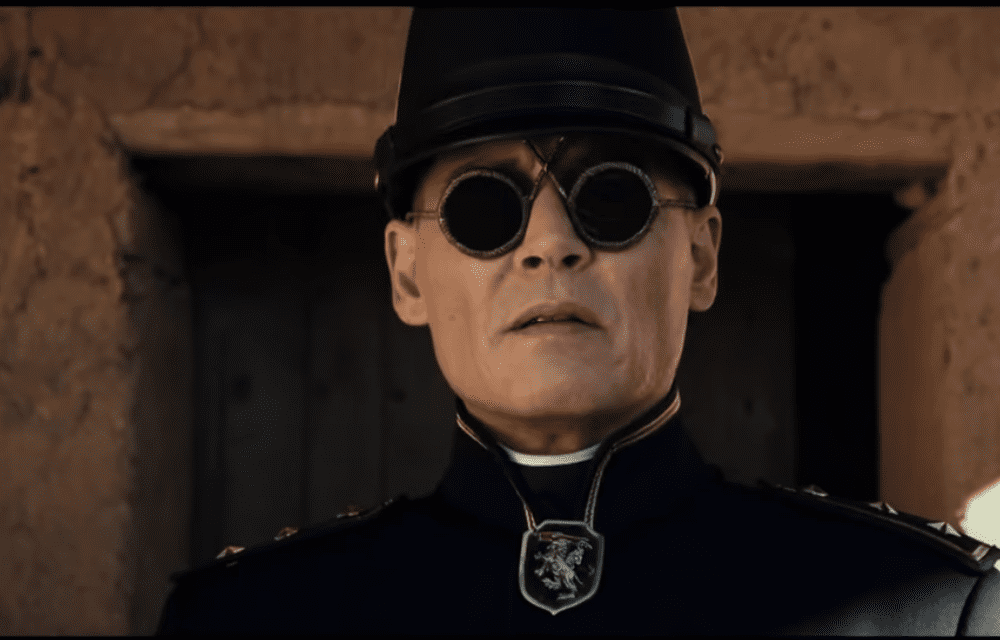Worth Waiting for the Barbarians?

America might be on the cusp of an anti-imperial turn.
Even with an “all-volunteer” military and wars put on the national credit card, a majority of Americans want their sons and daughters to come home from Afghanistan, Iraq, and other intractable expeditions in the back of beyond. Establishment politicians are at least singing the chorus of “ending endless wars,” however tunelessly. Director Ciro Guerra’s Waiting for the Barbarians would seem a perfect parable for this moment.
Like the 1980 J.M.Coetzee novel it is based on, the film is set in an imperial everywhere. Only the villains bear names; all else and all others are simply The: The Empire, The Frontier, The Magistrate, The Girl, The Barbarians.
Shot mostly in Morocco, Waiting for the Barbarians takes place in a desert fort on the French Foreign Legion archetype, albeit one with a bustling town and bazaar on its doorstep.
Mark Rylance’s anonymous hero is a benevolent colonial administrator on the hoary British model: a graying bachelor and scholar, devoted to his collection of native antiquities and his amateur archeology. He provides sympathetic if seemingly disengaged governance to his subjects, curtly resolving a dispute over a confiscated foraging swine so that he can return to his scrolls. He tells a friend that he will be content to pass away quietly “and merit no more than three lines in the Imperial Gazette: that with a nudge here and a touch there, I kept the world on its course.” The Magistrate walks alone through his town and seems to enjoy the goodwill and confidences of everyone he encounters.
Into this serene if sandy Shire comes a malevolent guest, no less so for being expected. Johnny Depp’s Colonel Joll arrives at the fort in a hellish little carriage, the kind of conveyance the Headless Horseman might have favored had he been a little higher born. In case the viewer has somehow missed the tonal shift, Joll and his small entourage are clad in dark blue serge, in contrast to the dusty working man’s whites of the Magistrate and his handful of conscript gendarmes. Rylance wryly tells a native friend that Joll is “not a soldier, he wears a uniform, but he’s not a soldier”—an unintentionally timely touch in this long hot American summer of camo-clad policemen and paramilitaries.
Joll has come from the Bureau of State Security, he informs the bemused Magistrate, to root out a plot on the Frontier, the dark designs of the nomadic Barbarians. The Magistrate protests briefly and questions a pair of jailed Barbarian sheep thieves, then meekly turns his prisoners over to Inquisitor Scissorhands.
Surprise, surprise: The Magistrate discovers that the Barbarians in his cells have been tortured and even killed. It’s an immediate and wholly predictable turn. One of his own men is seen buttoning his trousers as the furious Magistrate frees the prisoners and seeks answers. No foreplay—a perfect metaphor for a work that gallops through its plot with undue haste. Whole films could be (and doubtless have been) wrung from just the power dynamic of a native told to do something by an armed outsider. Guerra whisks us from meeting to murder in 19 minutes.
The Magistrate seeks atonement as Joll departs to extract more “truth.” He takes in the crippled daughter of a Barbarian Joll has murdered during an interrogation, who removes whatever illusions remain about what has been unleashed. The saintly Magistrate and the sadistic Joll are set on an inevitable collision course, driven by the Magistrate’s attempt to return the Girl to her people, a tribe of desert Mongols with muskets.
Unfortunately, Waiting for the Barbarians is hamstrung by its one-dimensional characters. Rylance seems to be drawing raves for his saintly Magistrate, but I’m not sure why. His mild-mannered martyr is just Christ in mufti, complete with nightly foot washings. He suffers his scourging and Passion stoically, with more of the savior than the stiff upper lip.
The laconic Depp is fine as far as it goes, but only his H.R. Giger-tribute shades are likely to stick in the mind for long. Robert Pattinson spends enough time on screen as Joll’s lieutenant to make the poster but provides the film only that: a jawline, a forelock, and a sneer. The handful of lesser characters make little more of an impression.
Waiting for the Barbarians is a visual treat and there are worse ways to spend 100-odd minutes. But there are also far better ones. This story of imperialism, fear, brutality, and courage has been better told on screen many times. Try The Battle of Algiers or Bruce Willis in The Siege. Better yet, cast parable aside and rent Taxi to the Dark Side to see America’s real Colonel Jolls, their victims, and their apologists.
And if it’s just kepis and desert forts you want, Beau Geste beckons. Gary Cooper and company are just a click away.
Gil Barndollar is a Senior Fellow at the Catholic University of America’s Center for the Study of Statesmanship.
Comments